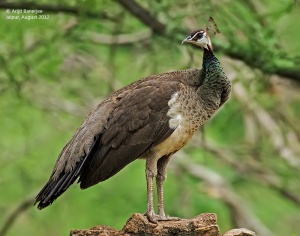Nutcracker (talk | contribs) m (format) |
(Attempt to disguise copied text. References updated. Video link) |
||
| Line 1: | Line 1: | ||
| − | [[Image:Indian_Peafowl.jpg|thumb|400px|right|Adult Male<br />Photo by {{user|Sumit|Sumit}}<br />[[Sariska National Park]], [[India]]]] | + | [[Image:Indian_Peafowl.jpg|thumb|400px|right|Adult Male<br />Photo by {{user|Sumit|Sumit}}<br />[[Sariska National Park]], [[India]], April 2001]] |
'''Alternative name: Common Peafowl''' | '''Alternative name: Common Peafowl''' | ||
;[[:Category:Pavo|Pavo]] cristatus | ;[[:Category:Pavo|Pavo]] cristatus | ||
==Identification== | ==Identification== | ||
| − | + | Male; 180–230 cm (80-90½ in); female 90–100 cm (35½-40 in)<br /> | |
| − | + | '''Male''' tail very long in breeding plumage 140–160 cm (50-63 in) | |
| + | *Bluey-green overall plumage<br /> | ||
| + | '''Female''' Long tail 32·5–37·5 (12¾-14¾) | ||
| + | *Dull greenish-grey plumage, with some [[Dictionary G-L#I|iridescent]] blue | ||
==Distribution== | ==Distribution== | ||
| − | East [[Pakistan]], [[India]] and [[Sri Lanka]]. <br /> | + | [[Asia]]: found in East [[Pakistan]], [[India]] and [[Sri Lanka]]. <br /> |
A popular cagebird for centuries and therefore feral populations are found in different places in the world. | A popular cagebird for centuries and therefore feral populations are found in different places in the world. | ||
==Taxonomy== | ==Taxonomy== | ||
Traditionally believed to be [[Dictionary_M-O#M|monotypic]]<sup>[[#References|[1]]]</sup>; but birds of [[Sri Lanka]] have been suggested as a second subspecies. | Traditionally believed to be [[Dictionary_M-O#M|monotypic]]<sup>[[#References|[1]]]</sup>; but birds of [[Sri Lanka]] have been suggested as a second subspecies. | ||
| − | |||
==Habitat== | ==Habitat== | ||
[[Image:Pavo cristatus female by ariban.jpg|thumb|300px|right|Female<br />Photo by {{user|ariban|ariban}}<br />Jaipur, Rajasthan, India; 8 August 2012]] | [[Image:Pavo cristatus female by ariban.jpg|thumb|300px|right|Female<br />Photo by {{user|ariban|ariban}}<br />Jaipur, Rajasthan, India; 8 August 2012]] | ||
Dry semi-desert grasslands, scrub and deciduous forests. | Dry semi-desert grasslands, scrub and deciduous forests. | ||
==Behaviour== | ==Behaviour== | ||
| − | + | They forage and nests on the ground but roost high in the trees. | |
====Breeding==== | ====Breeding==== | ||
| − | 4-8 light brown eggs | + | Eggs are laid on alternate days; the clutch consisting of 4-8 light brown eggs. Incubation is by the female alone and lasts for about 28 days. The male takes no part in raising the young as he is [[Dictionary_P-S#P|Polygynous]] with up to six hens. |
====Diet==== | ====Diet==== | ||
| − | + | They are an [[Dictionary_M-O#O|omnivorous]] species, eating seeds and green plants, fruit and berries, insects, some reptiles, including small snakes. | |
==References== | ==References== | ||
| − | #{{Ref- | + | #{{Ref-Clements6thAug14}}#Handbook of the Birds of the World Alive (retrieved July 2015) |
| + | #Wikipedia | ||
{{ref}} | {{ref}} | ||
==External Links== | ==External Links== | ||
{{GSearch|Pavo+cristatus}} | {{GSearch|Pavo+cristatus}} | ||
| − | [[Category:Birds]][[Category:Pavo]] | + | <br /> |
| + | {{Video|Indian_Peafowl}} | ||
| + | |||
| + | [[Category:Birds]][[Category:Pavo]] [[Category:Videos]] | ||
Revision as of 19:41, 30 July 2015
Alternative name: Common Peafowl
- Pavo cristatus
Identification
Male; 180–230 cm (80-90½ in); female 90–100 cm (35½-40 in)
Male tail very long in breeding plumage 140–160 cm (50-63 in)
- Bluey-green overall plumage
Female Long tail 32·5–37·5 (12¾-14¾)
- Dull greenish-grey plumage, with some iridescent blue
Distribution
Asia: found in East Pakistan, India and Sri Lanka.
A popular cagebird for centuries and therefore feral populations are found in different places in the world.
Taxonomy
Traditionally believed to be monotypic[1]; but birds of Sri Lanka have been suggested as a second subspecies.
Habitat
Dry semi-desert grasslands, scrub and deciduous forests.
Behaviour
They forage and nests on the ground but roost high in the trees.
Breeding
Eggs are laid on alternate days; the clutch consisting of 4-8 light brown eggs. Incubation is by the female alone and lasts for about 28 days. The male takes no part in raising the young as he is Polygynous with up to six hens.
Diet
They are an omnivorous species, eating seeds and green plants, fruit and berries, insects, some reptiles, including small snakes.
References
- Clements, J. F., T. S. Schulenberg, M. J. Iliff, D. Roberson, T. A. Fredericks, B. L. Sullivan, and C. L. Wood. 2014. The eBird/Clements checklist of birds of the world: Version 6.9., with updates to August 2014. Downloaded from http://www.birds.cornell.edu/clementschecklist/download/
- Handbook of the Birds of the World Alive (retrieved July 2015)
- Wikipedia
Recommended Citation
- BirdForum Opus contributors. (2024) Indian Peafowl. In: BirdForum, the forum for wild birds and birding. Retrieved 8 May 2024 from https://www.birdforum.net/opus/Indian_Peafowl
External Links





